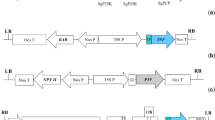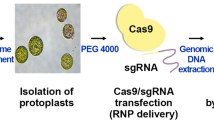Abstract
Plum transformed with an intron hairpin RNA CP (ihpRNA-CP) was resistant to plum pox virus (PPV) infection through the specific process of RNA silencing involving both small interfering-RNA (siRNA) and a methylated virus transgene. Silencing specifically targeted the PPV genome and led to the degradation of viral RNA in the model plant species Nicotiana benthamiana and the natural Prunus domestica host. Plums inoculated with the five major PPV strains, three widespread PPV strains (D, M, and Rec), and the atypical EA strain did not allow systemic spread of PPV in greenhouse-grown transgenic ihRNA-CP plum over multiple cycles of vegetative growth and cold-induced dormancy. PPV ihRNA-CP N. benthamiana displayed an immunity reaction and also allowed for the testing of PPV-C, a strain that was unable to infect P. domestica. This stable resistance demonstrated in plum based on the accumulation of siRNA can prevent PPV infection and can also act as a “curative” when PPV is inoculated through graft inoculation, through a recovery reaction. Regardless PPV strain variability based on geography, host species, epidemiology and serotypes of the CP protein and substitutions of nucleotides at the NH2-terminus of CP of the major five PPV strains tested, we show that the use of a PPV-CP intron hairpin (ihp) RNA is an effective strategy to specifically target the PPV genome. We provide methods and tools that demonstrate a reliable path towards developing PPV resistance suitable for protecting stone fruit orchards.




Similar content being viewed by others
References
Barba M, Hadidi H, Candresse T, Cambra M (2011) Plum pox virus. In: Hadidi A, Barba M, Jelkmann W, Candresse T (eds) Virus and virus-like diseases of pome and stone fruit. Am Phytopathol Soc St, Paul, pp 185–197
Calvo M, Malinowski T, Garcia JA (2014) Single amino acid changes in the 6K1-CI region can promote the alternative adaptation of Prunus and Nicotiana-propagated Plum pox virus C isolates to either host. MPMI 17:136–149
Cambra M, Capote N, Myrta A, Llacer G (2006) Plum pox virus and the estimated costs associated with sharka disease. EPPO Bull 36:202–204
Di Nicola-Negri E, Brunetti A, Tavazza M, Ilardi V (2005) Hairpin RNA silencing of Plum pox virus P1 and HC-Pro genes for efficient and predictable resistance to the virus. Transgenic Res 14:989–994
Di Nicola-Negri E, Tavazza M, Salandri L, Ilardi V (2010) Silencing of Plum pox virus 5″UTR/P1 sequence confers resistance to a wide range of PPV strains. Plant Cell Rep 29:1435–1444
Ding SW, Voinnet O (2007) Antiviral immunity directed by small RNAs. Cell 30:413–426
Dolgov S, Mikhaylov R, Serova T, Shulga O, Firsov A (2010) Pathogen-derived methods for improving resistance of transgenic plums (Prunus domestica L.) for Plum pox virus infection. Julius-Kuhn-Arch 427:133–140
Dunoyer P, Brosnan CA, Schot G, Wang Y, Jay F, Alioua A, Himber C, Voinnet O (2010) An endogenous, systemic RNAi pathway in plants. EMBO J 29:1699–1712
Eamens A, Wang MB, Smith NA, Waterhouse PM (2008) RNA silencing in plants: yesterday, today, and tomorrow. Plant Physiol 147:456–468
Garcia JA, Glasa M, Cambra M, Candresse T (2014) Plum pox virus and sharka: a model potyvirus and a major disease. Mol Plant Pathol 15:226–241
Harrison BD (2002) Virus variation in relation to resistance breaking in plants. Euphytica 124:181–192
Hartmann W, Neumüller M (2006) Breeding for resistance: breeding for Plum pox virus resistant plums (Prunus domestica L) in Germany. EPPO Bull 36:332–336
Hily JM, Scorza R, Malinowski T, Zawadska B, Ravelonandro M (2004) Stability of gene silencing-based resistance to Plum pox virus in transgenic plum (Prunus domestica L.) under field conditions. Transgenic Res 13:427–436
Hily JM, Scorza R, Webb R, Ravelonandro M (2005) Accumulation of the long class of siRNA is associated with resistance to Plum pox virus in transgenic woody perennial plum tree. MPMI 8:794–799
Hily JM, Ravelonandro M, Damsteegt V, Bassett C, Petri C, Liu Z, Scorza R (2007) Plum pox virus coat protein gene intron-hairpin-RNA (ihpRNA) constructs provide resistance to Plum pox virus in Nicotiana benthamiana and Prunus domestica. J Am Soc Hortic Sci 132:850–858
Ilardi V, Di Nicola-Negri E (2011) Genetically engineered resistance to Plum pox virus infection in herbaceous and stone fruit hosts. GM Crops 2:24–33
Jacquet C, Ravelonandro M, Bachelier JC, Dunez J (1998) High resistance to plum pox virus (PPV) in transgenic plants containing modified and truncated forms of PPC coat protein gene. Transgenic Res 7:29–39
James D, Varga A, Sanderson D (2013) Genetic diversity of plum pox virus strains, disease and related challenges for control. Can J Plant Pathol 35:431–441
Jan FJ, Pang SZ, Tricoli DM, Gonsalves D (2000) Evidence that resistance in squash mosaic comovirus coat protein-transgenic plants is affected by plant developmental stage and enhanced by combination of transgenes from different lines. J Gen Virol 81:2299–2306
Jones L, Hamilton AJ, Voinnet O, Thomas CL, Maule AJ, Baulcombe DC (1999) RNA-DNA interactions and DNA methylation in post-transcriptional gene silencing. Plant Cell 11:2291–2301
Kegler H, Hartmann W (1998) Present status of controlling conventional strains of Plum pox virus. In: Plant virus control. Am Phytopath Soc, 3340, Pilot Knob Road, St. Paul, Minnesota, pp 616–628
Kerlan C, Dunez J (1979) Differenciation biologique et serologique de souches du virus de la sharka. Ann Phytopathol 11:241–250
Kobayashi N, Horikoshi T, Katsuyama H, Handa T, Takayanagi K (1998) A simple and efficient DNA extraction method for plants, especially woody plants. Plant Tissue Cult Biotech 4:76–80
Kundu JK, Briard P, Hily JM, Ravelonandro M, Scorza R (2008) Role of the 25–26 nt siRNA in the resistance of transgenic Prunus domestica graft inoculated with Plum pox virus. Virus Genes 36:215–220
Levy L, Damsteegt V, Welliver R (2000) First report of Plum pox virus (Sharka disease) in Prunus persica in the United States. Plant Dis 84:202
Maejima K, Hoshi H, Hashimoto M, Himeno M, Kawanishi T, Komatsu K, Yamaji Y, Hamamoto H, Namba S (2010) First report of plum pox virus infecting Japanese apricot (Prunus mume Sieb. Et Zucc) in Japan. J Gen Plant Pathol 76:226–231
Malinowski T, Cambra M, Capote N, Zawadska B, Gorris MT, Scorza R, Ravelonadro M (2006) Field trials of plum clones transformed with the Plum pox virus coat protein (PPV-CP) gene. Plant Dis 90:1012–1018
Marandel G, Salava J, Abbott A, Candresse T, Decroocq V (2009) Quantitative trait loci meta-analysis of Plum pox virus resistance in apricot (Prunus armeniaca L.): new insights on the organization and the identification of genomic resistance factors. Mol Plant Pathol 10:347–360
Monticelli S, Di Nicola-Negri E, Gentile A, Damiano C, Ilardi V (2012) Production and in vitro assessment of transgenic plums for resistance to Plum pox virus: a feasible, environmental risk-free, cost effective approach. Annal Appl Biol 161:293–301
Moreno A, Fereres A, Cambra M (2009) Quantitative estimation of Plum pox virus targets acquired and transmitted by single Myzus persicae. Arch Virol 154:1391–1399
Nemchinov L, Hadidi A (1996) Characterization of the sour cherry strain of Plum pox virus. Phytopath 86:575–580
OEPP/EPPO (2006) Current status of Plum pox virus and sharka disease worldwide. OEPP/EPPO Bull 36:205–218
Olmos A, Bertolini E, Gil M, Cambra M (2005) Real-time assay for quarantine detection of non persistently transmitted Plum pox virus RNA targets in a single aphids. J Virol Methods 128:151–155
Petri C, Wang H, Alburquerque N, Faize M, Burgos L (2008) Agrobacterium-mediated transformation of apricot (Prunus armeniaca L.) leaf explants. Plant Cell Rep 27:1317–1324
Polák J, Jarošová J (2012) Susceptibility of plum trees cv. ‘Jojo’ to a Czech isolate of Plum pox virus strain D. Can J Plant Path 34:283–287
Powell G, Pirone TP, Hardin J (1995) Aphid stylet activities during potyvirus acquisition from plants and an invitro system that correlate with subsequent transmission. Eur J Plant Pathol 101:411–420
Ravelonandro M, Monsion M, Teycheney PY, Delbos R, Dunez J (1992) Construction of a chimeric viral gene expressing Plum pox virus coat protein. Gene 120:167–173
Ravelonandro M, Scorza R, Bachelier JC, Labonne G, Levy L, Damsteegt V, Callahan AM, Dunez J (1997) Resistance of transgenic Prunus domestica to Plum pox virus infection. Plant Dis 81:1231–1235
Scorza R, Callahan A, Levy L, Damsteegt V, Webb K, Ravelonandro M (2001) Post-transcriptional gene silencing in Plum pox virus resistant transgenic European plum containing the plum pox potyvirus coat protein gene. Transgenic Res 10:201–209
Scorza R, Georgi L, Callahan A, Petri C, Hily J-M, Dardick C, Damsteegt V, Ravelonandro M (2010) Hairpin Plum pox virus coat protein (hpPPV-CP) structure in ‘HoneySweet’ C5 plum provides PPV resistance when genetically engineered into plum (Prunus domestica) seedlings. Julius-Kühn Archiv 427:141–146
Scorza R, Callahan A, Dardick C, Ravelonandro M, Polak J, Malinowski T, Zagrai I, Cambra M, Kamenova I (2013) Genetic engineering of Plum pox virus resistance: ‘‘HoneySweet’’ plum—from concept to product. PCTOC 115:1–12
Smith NA, Singh SP, Wang MB, Stoutjesdijk PA, Green AG, Waterhouse PM (2000) Total silencing by intron-spliced hairpin RNAs. Nature 407:319–320
Thompson D, McCann M, MacLeod M, Lye D, Green M, James D (2001) First report of plum pox Potyvirus in Ontario. Can Plant Dis 85:97
Vidal E, Moreno A, Bertolini E, Perez-Panales J, Carbonell EA, Cambra M (2010) Susceptibility of Prunus rootstocks to natural infection of plum pox virus and effect of mineral oil treatments. Ann App Biol 157:447–457
Vitanova I, Dimkova S, Ivanova D (2004) Vegetative and reproductive parameters of introduced plum cultivars. J Fruit Ornam Plant Res 12:257–262
Wang X, Kohalmi SE, Svircev A, Wang A, Sanfacon H, Tian L (2013) Silencing of the host factor eIF(iso)4E gene confers Plum Pox Virus resistance in Plum. PLoS ONE 8(e50627):1–12
Waterhouse PM, Graham MW, Wang MB (1998) Virus resistance and gene silencing in plants can be induced by simultaneous expression of sense and antisense RNA. Proc Natl Acad Sci USA 95:13959–13964
Wetzel T, Candresse T, Ravelonandro M, Delbos RP, Mazyad H, Aboul-Ata AE, Dunez J (1991) Nuclerotide sequence of the 3′-terminal region of the RNA of the El Amar strain of Plum pox potyvirus. J Gen Virol 72:1741–1746
Zagrai I, Ravelonandro M, Zagrai L, Scorza R, Minoiu N (2011) Overview of the investigations of transgenic plums in Romania. Acta Hortic 899:153–158
Acknowledgments
This work was supported by the European Union via the contract Sharco-EU-FP7 number 204429 (2008–2012).
Author information
Authors and Affiliations
Corresponding author
Rights and permissions
About this article
Cite this article
Ravelonandro, M., Scorza, R., Michel, H.J. et al. The efficiency of RNA interference for conferring stable resistance to plum pox virus. Plant Cell Tiss Organ Cult 118, 347–356 (2014). https://doi.org/10.1007/s11240-014-0487-3
Received:
Accepted:
Published:
Issue Date:
DOI: https://doi.org/10.1007/s11240-014-0487-3




